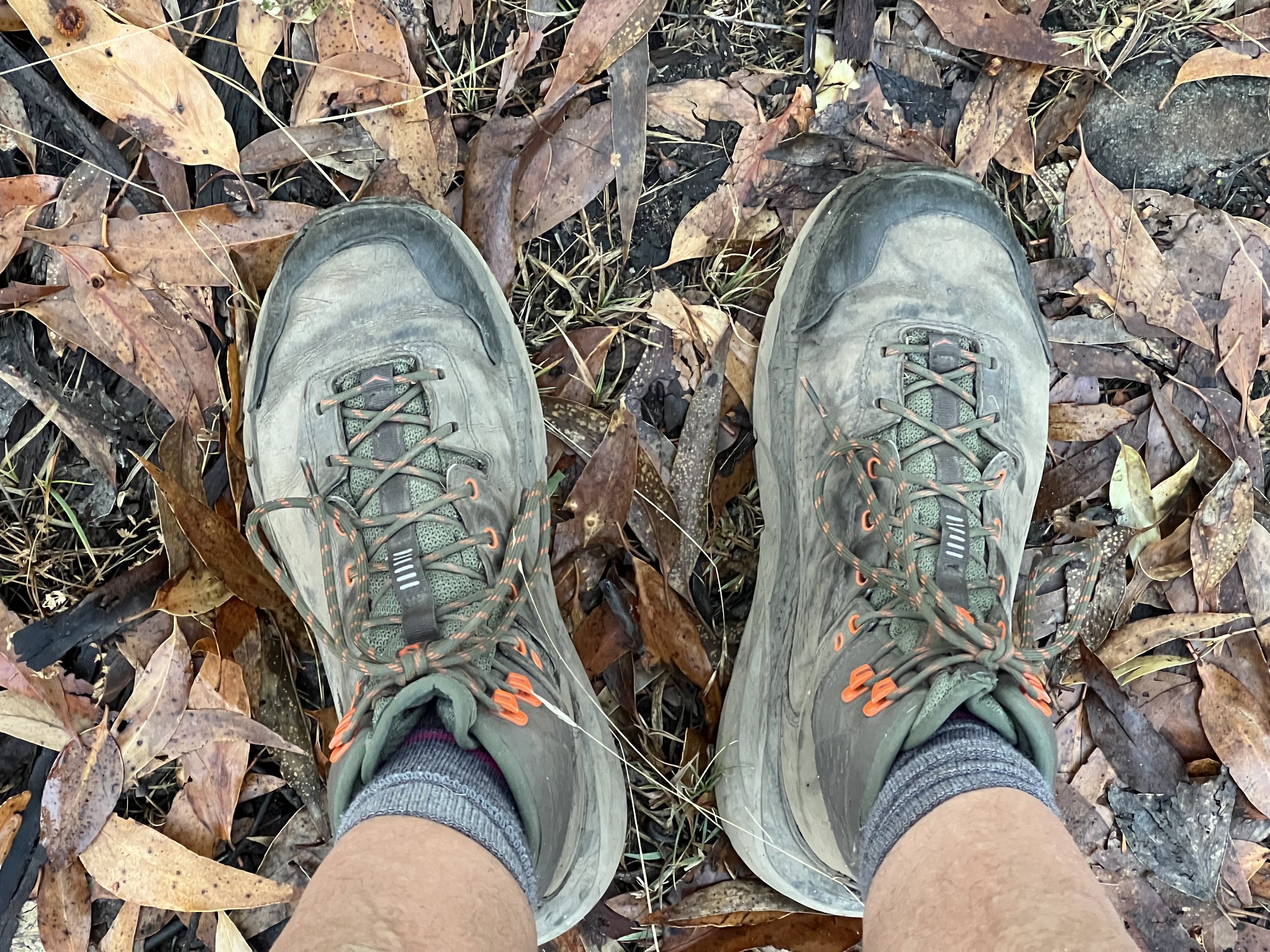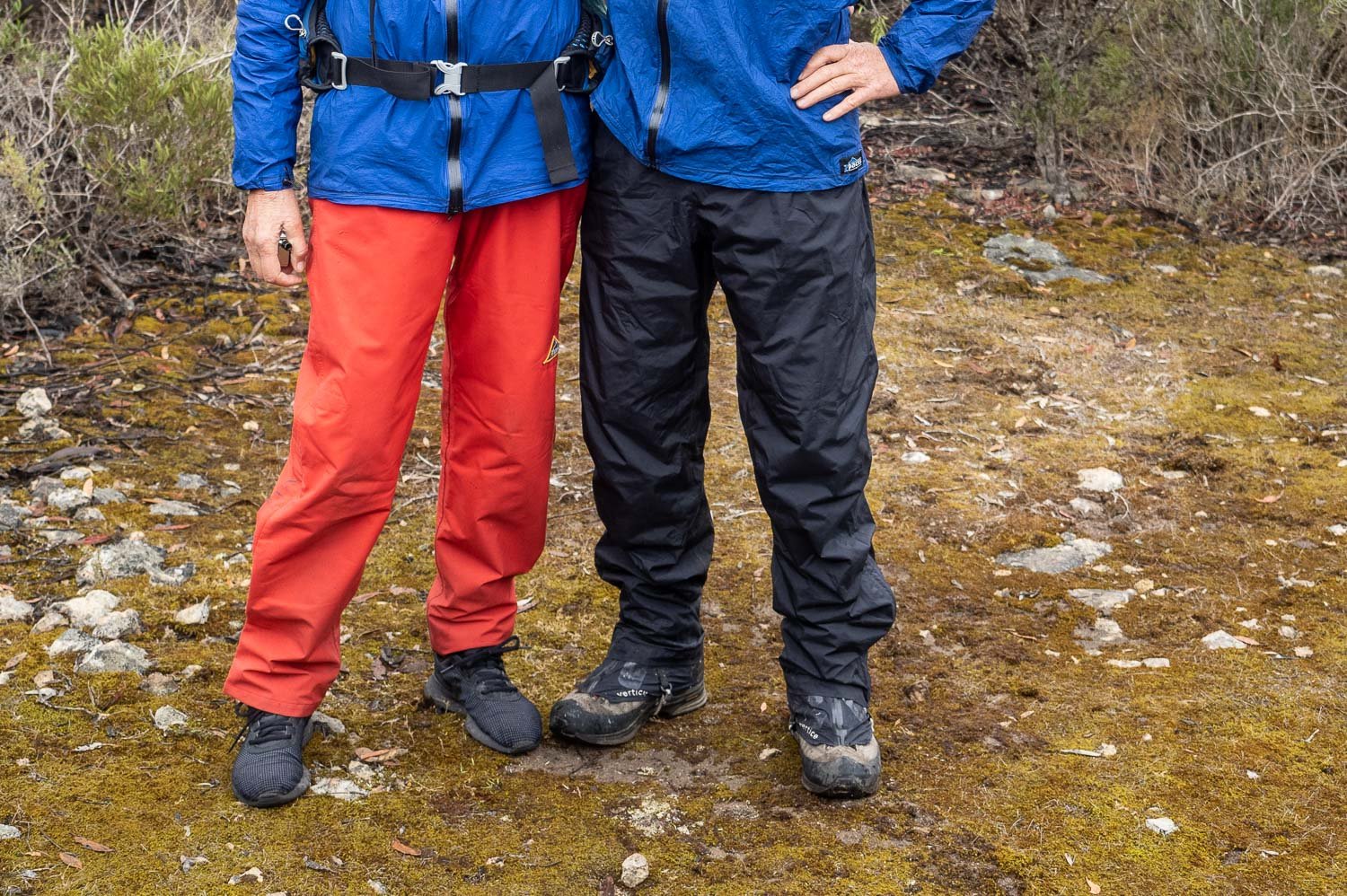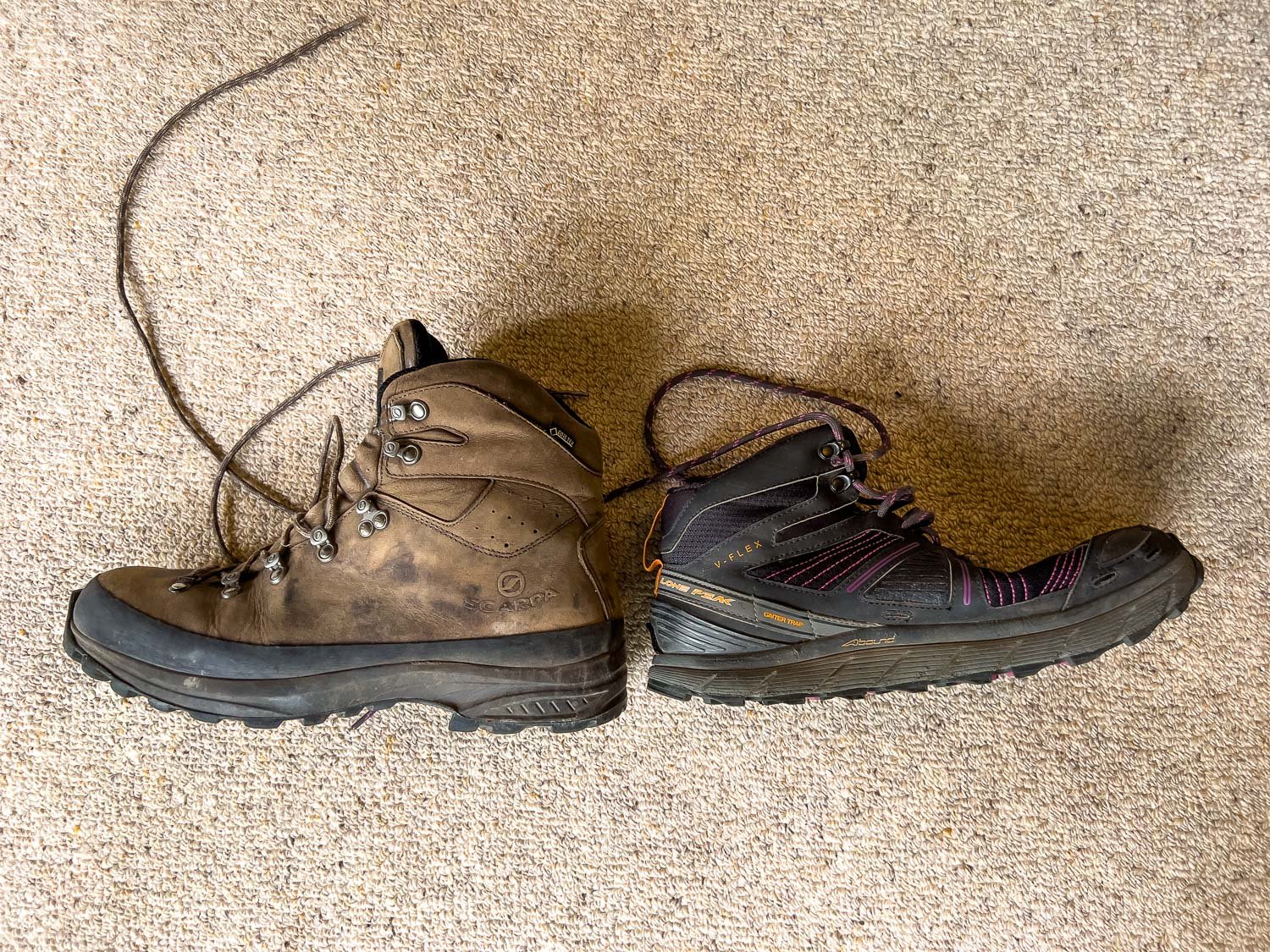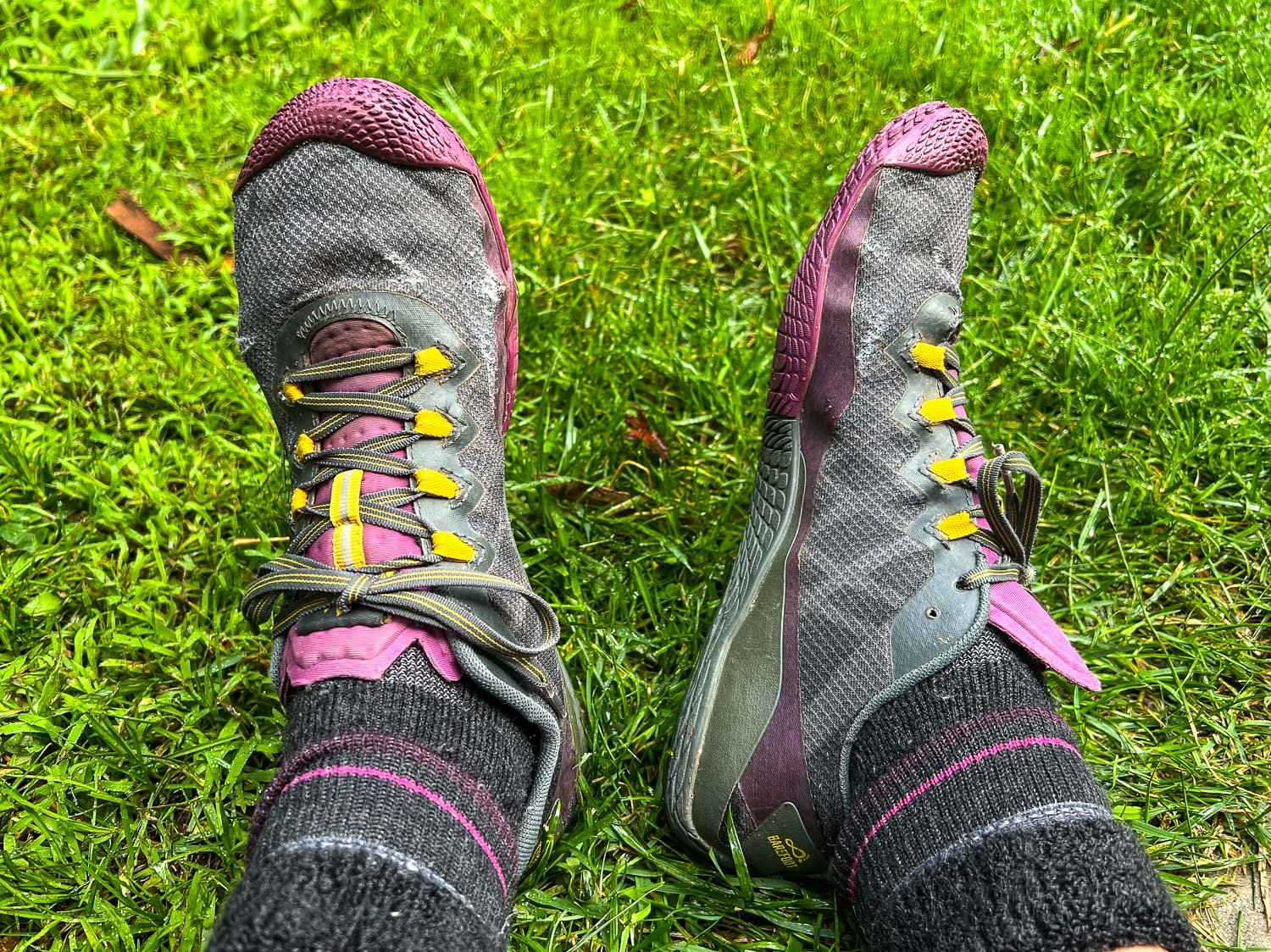How to Choose the Best Hiking Shoes for You
Hiking Boots, Shoes and Trail Runners
Zero drop or not? Waterproof or not? Trail runner or boot? Salomon, Keen, Merrel, Hoka, Scarpa, Altra? The list is endless, but we provide tools to help choose footwear that’s right for you.
My favourite hiking footwear: Hoka Sky Kaha were superseded by a new model that didn’t fit my foot, but which worked for Geoff.
Hiking footwear can make or break your hike. Your feet do a lion’s share of the work, so it’s worth giving them everything they need to succeed. But what things, precisely? If you’ve dipped your toe (sorry) into the hiking footwear pond, you’ll already know that a LOT of information is out there, and much of it is conflicting. Some hikers swear by waterproof footwear, while others insist you don’t need them. Some use boots, others trail runners. Toe socks or wool socks. Zero Drop or not? Why is there so much conflicting advice, and how do you begin to sort it out?
Unlike other articles, this one won’t tell you what to buy. Instead, we provide information to help you choose the footwear that best suits your needs.
Which footwear suits you best?
There is no one right or wrong answer: heavier boots or even sneakers can both be the correct choice
Feet ain’t Feet
Perhaps more than any item of hiking equipment, footwear is the most personal. It depends not only on the shape of your foot, but on climate, terrain, and the load you’re carrying. It depends on your gait and whether you’re running or walking. And of course, it depends on your personal preferences. In this article, we’ll (ahem) run you through all the considerations for everything footwear for hiking.
Because we are leisurely hikers here, we’re focussing on conventional backpacking, rather than trail running. And although Geoff and I have hiked in shoulder season snow and used minispikes, neither of us are familiar with northern hemisphere winter hiking, so find information on winter boots elsewhere. And finally, if you have specific foot problems, such as bunions, hammer toes, neuromas, bone spurs or tendonitis, read this article but consult your medical practitioners to confirm that your choices are suitable – neither Geoff nor I are podiatrists!
First we’ll consider the options: boots (mid or high) vs shoes/trail runners, waterproof or not, materials and soles. Next, we’ll consider actually buying the shoes, because this is not as simple as you might think. Then, once we have them, in Part Two we’ll consider associated important topics: camp shoes and/or river crossing footwear, socks, lacing, insoles and gaiters. And finally, we’ll consider the biggest bugbear: blisters.
But First: Don’t Fix What Ain’t Broke
Scarpas in Europe. Many hikers find these boots perfect, but I did not. How I hated them! I kept on with them for far too long only because they worked for Geoff, and I assumed that there was no better alternative for me. How wrong I was!
If your footwear is working for you, no need to change a thing. You’re the one who knows exactly how your feet feel at the end of the day’s backpacking. It’s common for feet to be tired and a bit sore, but normal healthy trail-fit feet should not be in terrible pain after a hike of 10-30 km. Stop reading if your feet always feel fine at the end of the day, because nothing can be better than what you have on your feet right now!
However, feet change over time. As you age, your ligaments lose elasticity, your skin gets drier and thinner, and you lose fat padding from the bottom of your feet (and that figures, doesn’t it? The bottom of your feet, not your bottom!).
The shoes you wear in daily life change your feet, too. After several years of wearing shoes with a wide toebox, I no longer fit comfortably into conventional narrow women’s hiking footwear… or narrow much of anything for that matter! Anyway, if you do notice that your shoes are no longer as comfortable as they used to be, try something different!
Altras
These shoes have a famously wide toebox
Geoff and I have had a succession of boots and shoes. We’ve worn different models of Keen, Salomon, Scarpa, Altra and Hoka; I wear a Merrel barefoot model at home. Geoff found that Scarpas work for him so, when he replaced them before our thru-hike, he chose the equivalent upgraded model. I admit that the journey has not been as straightforward for Princess Helen: Scarpas didn’t suit me at all.
My hiking footwear journey L to R: Salomons (2 pr), Altras, Hokas. I now wear Topos.
The gap is where the Scarpas were.
Boot, Shoe, Trail Runner or Hiking Sandal?
Despite what some people might have you think, there is no right or wrong answer to this, only what is right or wrong for you and your hiking conditions. Nor is it a new debate: seasoned Aussies will remember the famous white canvas Dunlop Volleys, which many wore in preference to leather hiking boots.
The much loved original Dunlop Volley, a bit worse for wear (Image Credit: Wikipedia)
There are several good reasons to wear trail runners and hiking shoes: they are light, and their lack of ankle support allows the joint to naturally strengthen. Both have more aggressive tread, support and cushioning than traditional sneakers. However, if you have a history of rolled ankles or sprains, this is something you should decide with your health practitioner before changing from boots, as you may need to strengthen tendons before heading onto rough ground with a pack. Remember that other factors contribute to a shoe’s stability, such as the construction and design of the sole.
Factors beyond the height of the cut contribute to a boot or shoe’s stability. The very wide heel of these Hokas greatly reduced rolled ankles for me.
Modern hiking boots are generally classified as mid- or high-cut. Mid boots cover the ankle but only just; a cutaway at the achilles allows a wider arc of movement. High cut boots fully cover the ankle and extend a short distance up the shin. Mountaineering boots are the heaviest, highest and most supportive.
You’ll need mountaineering boots for this terrain: Sandals won’t cut it!
Boots provide more support to the ankle joint and are often recommended for hikers carrying heavier packs but, again, personal preference takes precedence.
Some hikers (especially day hikers without packs) wear hiking sandals, but we see fewer in Australia because of our snakes. Mild Northern Hemisphere/European summers and well-formed tracks without gravel or grit are great for hiking sandals for those who prefer them.
Geoff in Keen hiking sandals. Perfect for a leisurely day walk, France.
Weight
Because we lift feet tens of thousands of times each day on a hike, the weight of footwear disproportionately affects the amount of energy used: a kilo on your feet is equivalent to five kilos on your back. When the lightest trail runners and hiking shoes weigh a fraction of hiking boots, this equates to a lot of energy saved every day.
We’ve hiked with a friend who wore steel capped work boots, which we wouldn’t recommend, but nearly all modern hiking boots are much lighter than they used to be. Geoff’s new Scarpas are still heavy at 1404g (49.5oz)/pair, but his previous ones were 1664g (58.7oz)/pair. My Altra mid boots were just 740g (26oz)/pair. This is not heavy for waterproof hiking boots; many ordinary shoes weigh more than this.
Geoff’s Scarpas old and new
When researching online, be aware that weights quoted for some footwear is per shoe rather than per pair, and may not be consistent across brands for size.
I prefer mid-cut boots but with a soft collar as a Goldilocks compromise between a light unsupportive trail runner and a heavier constrictive high cut leather boot. Think about yourself and the kind of hiking you do – which would you prefer?
Materials
Modern footwear materials of suede and/or synthetics are lighter, more flexible and are often comfortable straight out of the box, rather than having to be worn in like full grain leather boots. However, there is something to be said for well-maintained leather hiking boots. Although they’re less breathable than lighter boots, they can be solidly waterproof, extraordinarily comfortable as they mould to your foot, and last many seasons longer than synthetic ones. Numerous folk still swear by them, as do those who hike in snow.
Waterproof or Not?
This is yet another ubiquitous debate in hiking forums. As is often said, no boot is truly waterproof because there’s a big hole in the top! However, if you’re hiking in cold, wet weather, you may prefer waterproof boots so that your feet stay warm, if not dry. Fast-drying, cool and breathable non-waterproof boots are great for warm conditions but, really, it’s personal preference.
There is a difference between different brands and even models of waterproof hiking boots. My ‘waterproof’ Altra mid “RSMs” (rain snow mud) soaked through at the forefoot after just ten minutes of walking through ankle-high wet grass; newer models may have improved.
The superseded model of my Hoka boot was also known to fail relatively quickly, whereas the subsequent model with a different liner is significantly better: my feet only got wet on days of wading during our Bibbulmun thru-hike. Many excellent boots and shoes are now made in waterproof and non-waterproof models so, if you have a pair you like and are considering changing, check to see whether this is the case.
Left: Altra mid mesh boot – sadly no longer made. Similarly, the same thing happened to my favourite Topo non-waterproof boot with a similar, minimal drop mid model that was fast-drying, breathable and very lightweight.
Right: ‘waterproof’ RainSnowMud version.
For our Bibbulmun thru-hike, we chose waterproof boots despite the infamous five day wading section, where fast-draining, quick-drying footwear is preferable. This meant that we had completely dry feet for 69 days, and sloshingly drenched ones for five. Other people wore non-waterproof footwear but it was an abnormally wet season, and many of them had many more days of wet feet the rest of the time because it was too cold and showery for their shoes to dry. During a drier season, non-waterproof footwear may be the better choice.
Five days of sloshing.
No boot is waterproof in this, except perhaps thigh high rubber waders!
Cool, light, breathable, non-waterproof footwear certainly makes sense for hot trails like the Larapinta in central Australia, or ones that involve wading in warm weather, like the Jatbula. Walks with numerous river crossings, such as many in New Zealand, can also suit non-waterproof, fast-draining and drying boots, shoes and sandals.
Hiking sandals for a day walk in New Zealand: perfect!
If you’re buying new footwear, consider where and when you do most of your hiking, and choose accordingly. However, no need to worry: wet feet in and of themselves are not an issue if you have appropriate socks, and care for your skin to prevent blisters and fungal diseases. The worst part is donning cold, wet socks in the morning!
Shape of shoes
Some boot and shoe brands have a narrower fit than others, or are large or small for their sizing. If you have had one brand that fits your feet well and are considering a new pair of shoes, look within that range first, because other models are also likely to fit you well.
Certain brands or ranges, notably Altra, Moab, Topa, Lowa and Hoka, have a particularly wide toebox or extra wide fittings. Once you’ve worn them for a time, you’re unlikely to return to conventional shoes not only because of the comfort, but because you may no longer fit into them, as happened to me. Wide toeboxes allow the forefoot and your toes to splay naturally, and change the biomechanics of the foot when you walk in the same way as happens in bare feet.
Altras look a bit like clown shoes, but they are famously ‘foot-shaped’ and comfortable. I’d still be wearing them for many hikes if I could.
Rand Size and length
The rand is a strip of rubber that runs varying distances around the bottom edge of the boot, starting at the toe. Depending on the level of protection, the rand can be just at the toe, or run right to the heel. The rand can minimise stretching of the shoes, protects the toe and sides, and extends the life of shoes especially in rocky country.
Soles
Hiking footwear soles are made of multiple layers and are highly technical; details are beyond our level of expertise. However, these layers combine to provide a certain level of cushioning, protection and flexibility (shank/rock plate) and grip (outsole). It is the different materials, combinations, stiffness and thicknesses of these layers that give different brands, trail runners, hiking shoes and boots their characteristic feel. Thicker rock plates have less flex, but also provide more protection on uneven stony ground. Geoff with his heavier pack prefers the stiffer Scarpas with their thicker rock plate; I can wear a lighter, more flexible boot with my lighter pack.
Our friend, carrying under 3 kg, preferred light sneakers on her hike with us; Geoff, carrying considerably more, preferred his Scarpas.
Some people prefer the responsiveness of trail runners to better feel the ground through the sole: you don’t need to be a runner to wear them, and many leisurely hikers prefer them. Again, this is no longer the province of trail runners alone: many light hiking boots such as Altra Lone Peaks have adopted runner characteristics and have thin, flexible soles. I found them a little too thin for rocky terrain, in exactly the way this review describes, but they are one of the most popular thru-hiking shoes/boots, so many people find them just right. Such flexible footwear is ideal for day-hiking.
Bendy Altras
Stiff Scarpas
You can see the difference in flexibility of these models of Altra and Scarpa: even with a white knuckle grip this was as far as Geoff could flex the latter. My Hokas are somewhere in between.
Grip vs longevity
Boots with excellent grip on wet rock generally have aggressive tread and relatively soft, ‘sticky’ rubber (Vibram is the industry standard). The trade-off is that these softer rubbers wear more quickly.
Rocker Soles vs Heeled Soles
When you pick up most trail runners, you’ll notice that they are not completely flat, but are curved upwards at the toe and at the heel. This is known as a rocker sole. The curve can be slight, or significant. My orthoticist explained that one huge advantage of rocker soles is they reduce strain on the joints (particularly the ankle and knee), tendons and foot itself by promoting a smooth rolling gait.
However, rather than having a conventional heel and instep, many hiking boots and shoes now also sport this feature. I found rocker soles transformative: the Goldilocks combination of modest support, mid cut, cushioning, plus rocker sole (and orthotics!) has kept me on the track.
Altra with a rocker sole and traditional heeled Scarpas with an instep
Zero Drop Shoes
When you walk on bare feet, your heel and forefoot are both on the ground and at the same height relative to each other: at zero. When you wear a shoe with a heel, there is a drop in level from your heel to your toe. High-heeled evening sandals might have a ten centimetre drop. Most hiking boots have 10+ mm drop, but some models have zero drop. These include various Merrels, Altras and Hokas.
Heeled shoes change the biomechanics of your gait by shortening the muscles in the backs of your legs, all the way from your glutes, hamstrings, calves to achilles and plantar tendons (the rear drive train). When you change from a heeled shoe to a zero drop shoe, these muscles and tendons are stretched, particularly when you lean forward, or when your foot is angled upwards, both of which happen on a steep ascent. This is why it’s essential to become accustomed to zero drop shoes gradually by wearing them for short periods initially, and gradually lengthening the time you spend in them.
Be aware that wearing zero drop shoes after they’re worn out can cause them to become negative drop ie lower at the heel than the toes. This causes real problems, so don’t be greedy with them – change them out when they reach their use-by date.
I find hiking down steep inclines significantly easier in zero drop shoes, but steep uphills more difficult. Even though I’d been wearing Altras for a few years, it was the very steep Fimmvorduhals Trail in Iceland that damaged my achilles tendon while wearing them. Plantar fasciitis can also be exacerbated, especially if the model has no arch support. Although many folk swear by zero drop shoes, be aware of potential issues and consult your podiatrist if you have any chronic foot problems. If you do get any tendinitis , get it correctly and promptly treated.
Views from the spectacular but steep Fimmvorduhals Trail in Iceland…
lifetime memories worth the steep price of ignoring the ensuing tendinitis!
My current Hokas, with a very small drop of just 6mm, are my just-right shoes when combined with orthotics. Geoff wears standard heeled Scarpas. Think about the characteristics of your Goldilocks boot or shoe, and search out models that have those that you want.
Barefoot Shoes
Some people happily hike in ‘barefoot’ shoes. As you’d expect, these shoes are light, with thin flexible soles designed to mimic the feeling of bare feet. The sole is just thick enough to prevent puncture injuries and provide grip; they have no arch support and they are, of course, zero drop. People who walk around everywhere in actual bare feet develop thick protective calluses on their soles, but most people nowadays wear shoes too often for this to happen; barefoot shoes mimic the effect.
I wear a pair of Merrel barefoot shoes around home and to the shops. I bought them at an incredibly cheap sale price: one advantage of large feet is that my size is often remaindered! They are comfortable but, as an older person with less fat padding on the soles, as well as chronic tendon issues, there is no way I could hike in them. However, if you have strong, healthy feet and the idea appeals to you, many people can and do hike successfully in them. As for zero drop shoes, wear them in gradually so that your body has time to adjust to the new biomechanics.
I wear these Merrel barefoot shoes around home and for short hops around the shops, but not for hiking.
Buying Hiking Footwear
Many wonderful hiking products are available online, including hiking boots and shoes. However, if there is one thing that’s worth buying in a bricks and mortar store, it is hiking footwear: you only need to look at any used gear market to see the numerous as-new secondhand boots for sale, often in their original box, because they were the wrong size or fit.
These new secondhand Zamberlan full grain leather boots are a fantastic bargain for someone… just not the person who first bought them!
If you’re after hiking boots on a budget, look also at tradie suppliers for full grain leather and suede boots such as some of the ones on this page, remembering that full grain leather boots often take time to break in.
Try in the Shop, Buy in the Shop
This shouldn’t need saying but, if you go into a shop to try on shoes and the staff help you find a pair that fits you properly, be a decent human being and buy them there. Don’t be one of those shitty customers who try them on and then buy elsewhere online for a slightly cheaper price: cheaper only because that outlet doesn’t have any storefront or helpful staff.
You may also be pleasantly surprised by instore pricing. Because they were available nowhere else in Adelaide, I bought my Hokas from a pricey shop. At the checkout, I asked whether there was any chance of a discount. The shop owner punched keys and, to my amazement, the price ended up slightly cheaper than what I’d seen online once postage was added!
Sales
Take advantage of sales: when new shoe models are released, superseded ones may be heavily discounted. People with particularly large or small feet are often lucky. And once you have footwear you like, look for those as-new boots on second hand marketplaces.
Other Tips for Instore
Keep an open mind: you may have researched a model that seems perfect but, if it doesn’t feel right, don’t be afraid to try different brands. Don’t be a brand snob: cheaper or less popular ones might suit your foot better!
If you’re on a budget, cut your costs anywhere else rather than on shoes, especially if you have chronic foot issues. Buy the shoes that fit best and meet your hiking needs. Buy a cheaper tent if you must, but make sure those shoes are right!
Try on shoes in the afternoon after walking around town for an hour or two when your feet are warm (they swell). Many people buy a half or even full sizer larger to account for feet swelling on long hikes.
Walk around the shop with a weighted pack
Buy for your largest foot (feet are rarely exactly the same size)
Leave a thumb width gap at the toe end. Check this by completely loosening the laces of your shoes and pushing your foot right to the front. There should be a thumb width space between the back of your heel and the shoe.
Wear your hiking socks, bring your insoles if you use them
Hiking shoes should cinch firm but not tight, and allow for some movement without being loose
Try on the opposite sex’s model if going up or down a size in your own isn’t working. If the shoes are almost perfect and you’ve found nothing better, try on a pair of thicker or thinner socks or
Experiment with lacing techniques (see Part Two)
Use the incline board if the shop has one to see whether your feet are held firmly without slipping forwards inside the shoe.
Repairs and Replacement
Our neighbourhood village has a cobbler – yes, a real one! – but unfortunately today’s disposable culture means that most hiking footwear is designed to be used and discarded, rather than repaired. People nevertheless send him their favourite shoes to repair not only from all around Australia, but from as far away as Japan. Sadly, our cobbler explained that modern construction methods mean that repairing or resoling hiking boots is rarely possible. However, if you have a pair of traditional full grain leather boots, they can often be resoled.
Boots drying
Our cobbler also explained that the worst thing that you can do to your boots or shoes is to place them next to the fire – or, for leather, even in hot sunshine – to dry out. This not only damages full grain leather, but also weakens glues and bonding and causes layers in the sole to separate. Resist the temptation!
Once you find the right shoe, find the left one!
























